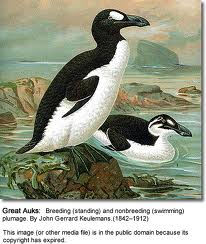Early on the morning of June 3, 1844, two great auks tended their nest on a rocky ledge on Eldey Island off the coast of Iceland, taking turns keeping their egg warm. At one time the flightless bird habited the coastlines and islands in Iceland, southern Greenland, Ireland and across the ocean to Newfoundland and as far south as Florida. But as men began to inhabit these areas, the garefowl, as the auk were often referred, were captured for their black and white plumage, as well as for food.
Natural-history museums in the United States and Europe were offering bounties for endangered bird species, hoping to obtain skins or eggs to add to their collection before the birds became extinct. In 1830, museums in Iceland were paying 100 kronen (about 30 dollars in the mid-1800s) for each garefowl. In the next ten years, seventy skins and fourteen eggs were taken from Eldey Island, satisfying the market and generating reports that the species was no more.
Four years later, collector Carl Siemsen received a request from a dealer in Europe, pleading for one more great auk skin. Siemsen urged fisherman Vilhjalmur Hakonarsson to gather a group of men for one more trip. Fourteen men set sail for Eldey Island. The rough seas threatened to bash the Hakonarsson’s boat as he tried to anchor near the rocky shore. Only one trip ashore in the dingy would be allowed. Jon Brandsson, Sigurdr Islefsson, and Ketil Kentilsson were chosen to go. When the men reached the nesting site, the great auks showed little sign of alarm. As they ambled away from their nests, Jon Brandsson cornered one and grabbed it easily. Islefsson and Kentilsson seized the second bird as it stood on the edge of the rock. In one swift motion, the necks of both birds were rung. Noticing a crack in the egg, Kentilsson tossed it over the cliff. In less than five minutes, the great auk was extinct.
In his book, On the Trail of Vanishing Birds, Audubon ornithologist, Robert Porter Allen, relates this chilling account of blatant disregard for an endangered species in his last chapter, “The Long Flight Back.” Learning of this event was just one of the many inspirations that fueled Allen’s desire to make a difference in the world of bird conservation.
Tomorrow I return to my blog tour with John Desjarlais who is hosting me on his blog. My topic:
Is stepping into the role of Sherlock Holmes as easy as stepping into a pair of Persian slippers?
Tomorrow I return to my blog tour with John Desjarlais who is hosting me on his blog. My topic:
Is stepping into the role of Sherlock Holmes as easy as stepping into a pair of Persian slippers?


